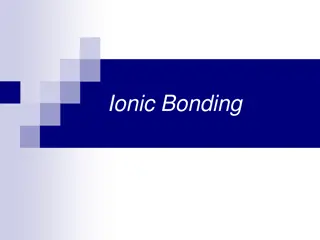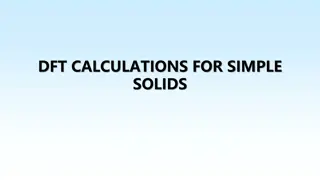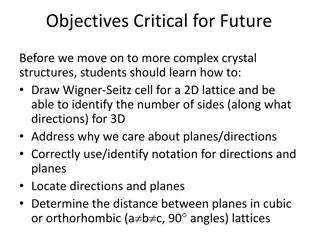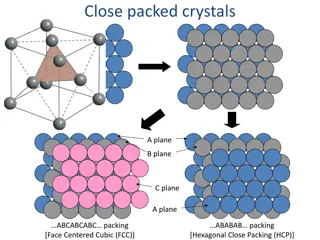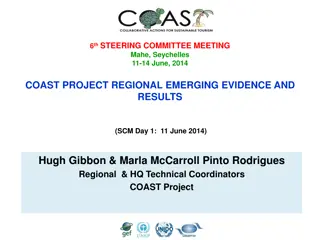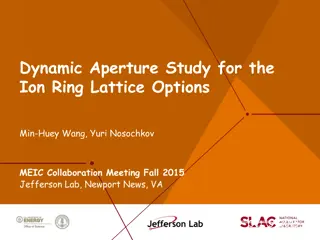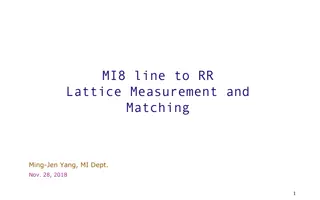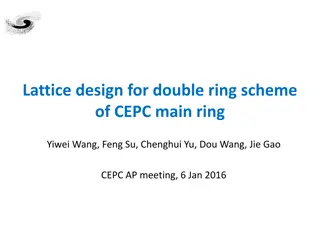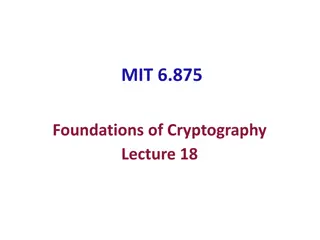
Advanced BAPS Lattice Design for High-Energy Operation
Explore the innovative BAPS lattice design by Xu Gang at IHEP, Beijing, focusing on linear lattice design, damping wigglers, chromaticity correction, and high-flux operation modes. Discover the detailed goals and specifications for this cutting-edge facility to achieve high brightness and beam current for X-ray applications.
Download Presentation

Please find below an Image/Link to download the presentation.
The content on the website is provided AS IS for your information and personal use only. It may not be sold, licensed, or shared on other websites without obtaining consent from the author. If you encounter any issues during the download, it is possible that the publisher has removed the file from their server.
You are allowed to download the files provided on this website for personal or commercial use, subject to the condition that they are used lawfully. All files are the property of their respective owners.
The content on the website is provided AS IS for your information and personal use only. It may not be sold, licensed, or shared on other websites without obtaining consent from the author.
E N D
Presentation Transcript
BAPS Lattice Design XU Gang IHEP, Beijing, China Oct. 30, 2012, Huairou, China
Topics Goals Linear lattice design Damping wiggler Round beam Chromaticity correction Summary
Design Goals E=5GeV Circumference 1200~1500m High brightness operation mode Emittance 10pm/10pm(diffraction limit for 10keV X-ray) Beam current 100mA~150mA High flux operation mode flat beam(no damping wiggler) Beam current 200mA~300mA Large enough dynamic aperture for injection
Linear lattice design 7BA*36 25mm magnet pole diameter, combined bending magnet 15BA*16 25mm magnet pole diameter, combined bending magnet 6BA*40 48mm magnet pole diameter, quadrupole with sextuple components Damping wiggler 31mm period 2.3Tesla damping wiggler about 60m Round beam local: solnoid+ID+antisolenoid global: Mobius ring or other
7BA*36 Linear Optics Circumference: 1364.8 m, 2 superperiods, 36 supercells Working point: 111.39, 39.30 Natural chromaticity: -184, -181 Natural emittance: 51 pm.rad Y. Jiao, IHEP BP Seminar 5
Lattice layout in one superperiod 7-m low-beta straight section High-beta 10-m Straight section *2, x/y= (80, 21) m; Low-beta 7-m Straight section *36, x/y= (5,1.11) m ; Phase advance per supercell: (6 + /6 + x /36, 2 + /6 + y /36) with x= 0.39, y= 0.30. Y. Jiao, IHEP BP Seminar 6
Dynamic aperture Large enough on-momentum DA, satisfies the requirements of pulsed sextupole injection; Momentum acceptance is not large, ~ 1.5%, not long Touschek lifetime. However, this can be cured with top-up injection. On-momentum DA Off-momentum DA Y. Jiao, IHEP BP Seminar 7
Black: bare lattice, Green: multiple error=10-4, Blue: multiple error & bending error
Injection insertion xinj= xstd+2 yinj= ystd Keep the symmetry for linear lattice Help for dynamic aperture for on-momentum Straight length>9m for pulse sextupole injection
PSM: pulse sextupole magnet for injection, L=0.6m, 1000Tesla/m2 52mm pole diameter bottom width<4 s (details ref. KANG Wen also JIAO Yi talk) SEP: Septum magnet Straight length 9.2m >5mm dynamic aperture
Lower section with double wraists x=3m, y=1m, straight section 7m*2 Canting structure is neccesary
higher section for injection x=80m, y=8m, middle straight section 9.2m for injection xinj= xstd yinj= ystd(hope improve dynamic aperture for off-momentum)
Middle section for Mobius ring x= y=7m, straight section 14m xMob= xstd yMob= ystd Length between the two arc bending magets is equal to each other for high beta and middle beta section
Damping wiggler effects Damping wiggler (DW), peak field 2.3 Tesla, Undulator period 3.1 cm, 40-m DW 20 pm 50-m DW 17 pm 60-m DW 15 pm 70-m DW 14 pm Lu(m) u(m) Y. Jiao, IHEP BP Seminar 17
Round beam Local round beam 1.75m 15Tesla solenoid( /4 x-y rotating ) +2.5m ID(circle polarity EPU is best for decouple) + 1.75m 15Tesla anti-solenoid (- /4 x-y rotating ) at least 6m space local scheme by A. Chao and P. Raimondi Global round beam: /2 x-y rotating solenoid(Mobius ring) other method
x= (AA DD-BB CC) Cos[(c z)/2]2 y= (AA DD-BB CC) Sin[(c z)/2]2
Chromaticity correction Up to 5thorder DA map( polynomial ) with sextupole, octupole, decuple, duodecupole strength variables(can reach to about 30 variables) Up to 6thorder corresponding Hamiltonian Up to 4thorder chromaticity Up to 2nddetuning coefficients Up to 6thresonance coefficients Optimizing chromaticity curve under controlling detuning and resonance coefficients (mainly on 3rdorder and 4thorder)
Summary The lattice design of BAPS is still in progress. To reach diffraction limit very strong damping wiggler and solenoid is necessary in our design The dynamic aperture for bare lattice and 10-4 multiple error looks acceptable for pulse sextupole injection For NBA structure, N=7 is popular in USR design, How large N(>7) is applicable?




